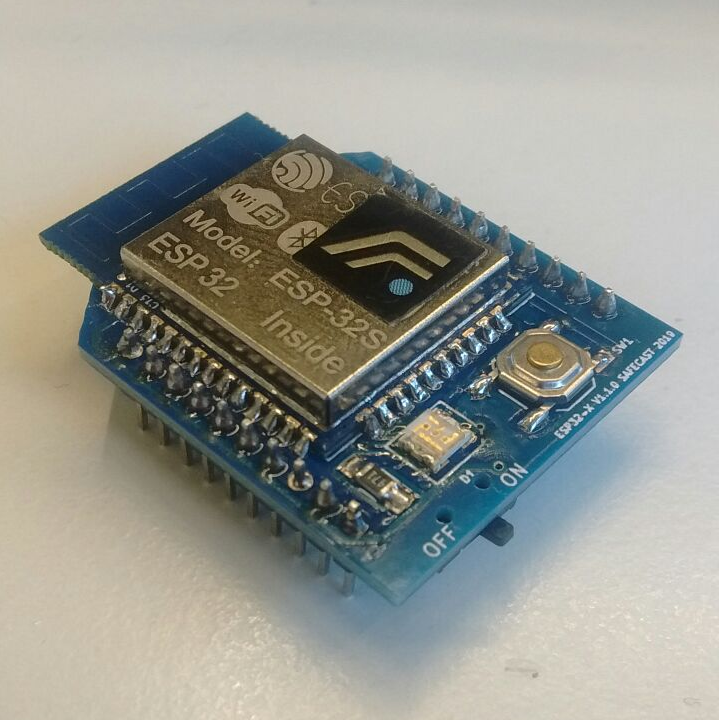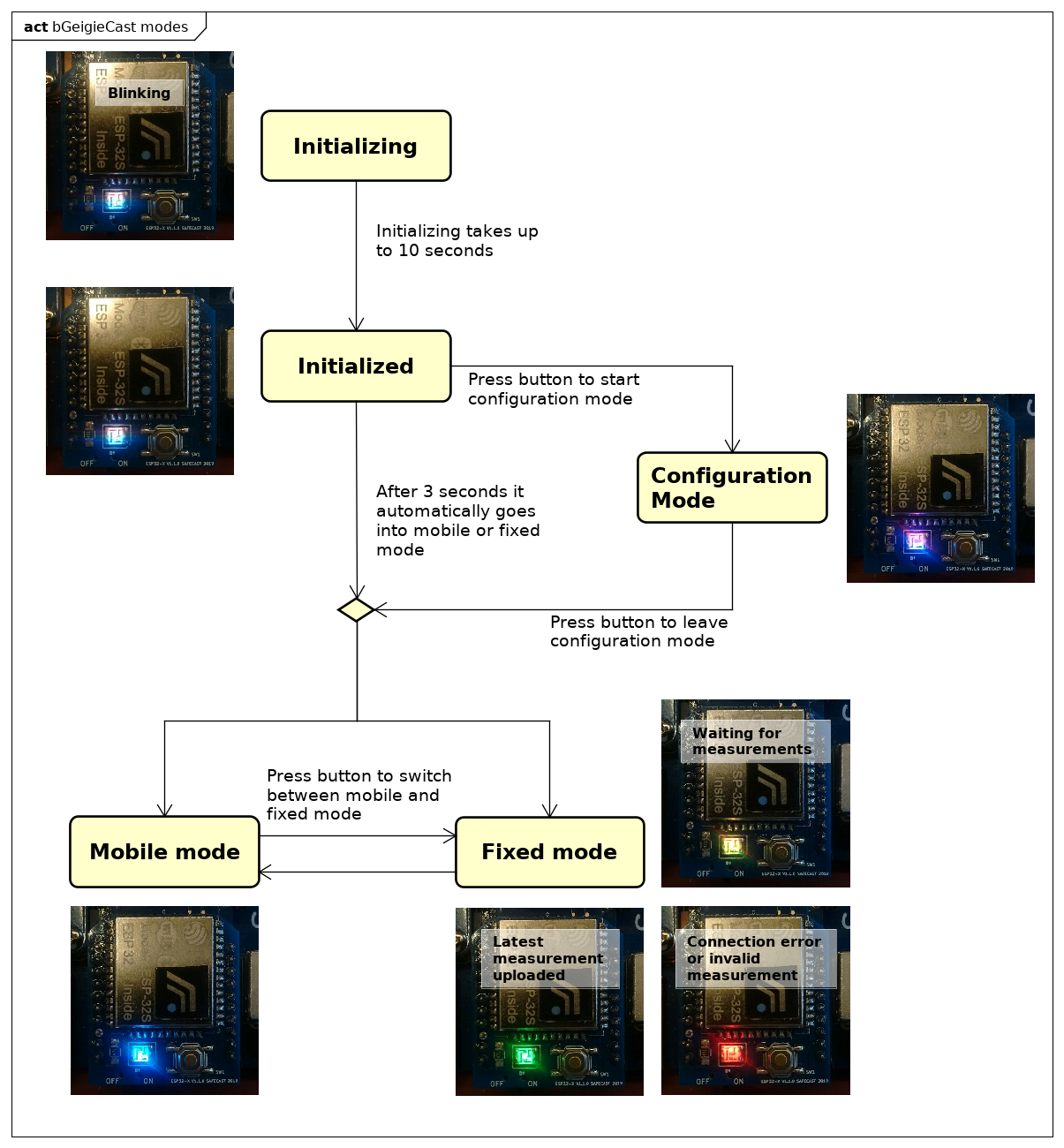-
Notifications
You must be signed in to change notification settings - Fork 3
Home
Welcome to the bGeigieNanokit-Xbee wiki!
- General information
- Hardware
- Modes
- Using the module
- Configuring and updating
- Join development
- Troubleshooting

The bGeigieCast module was created to solve an issue with the existing bGeigieNano: The bGeigieNano can only be used as a mobile sensor. With the bGeigieCast module, the bGeigieNano can configures as a fixed sensor and send measurements directly to the API, without the need to manually upload log files.
The bGeigieCast is a XBee module, which should be placed on top of the FIO (it replaces the BLEBee). The module consists of an ESP32 micro controller, a power switch, a mode button, and an RGB LED.
Additional hardware for a complete fixed mode sensor are:
- Wireless charging dock
- Wireless receiver, connected to the bGeigieNano
- Wireless transmitter
For more information about the wireless charging parts, check out SOME_OTHER_DOCUMENT
The bGeigieCast module knows 3 modes, one for configuring the module and two others for handling the measurements in different ways.
Allows the user to connect to the module and configure different settings
The module will publish measurements over bluetooth. Apps like Safecast Drive can be used to connect to the bGeigieCast
The module will publish measurements every 5 minutes directly to the API. Configurations for this can be set while in configuration mode.
Interaction with the module is quite simple, as there is only a single button. In the following diagram, the different modes and LED representations are described.
After turning the device on, the module will start in "Initializing" mode. Once it stops blinking, it is initialized and ready to use.

Colors that indicate the current mode of the module. In the configurations there is an option to change between default and colorblind colors.
| Default | Colorblind | Description |
|---|---|---|
| White (BLink) | White (BLink) | Module is starting up, takes up to 10 seconds |
| White | White | Module has been initialized, this state lasts 3 seconds |
| Purple | Purple | Module is in configuration mode |
| Blue | Blue | Module is in mobile mode |
| Yellow | Yellow | Module is in fixed mode, waiting for the first measurement to send. This takes about 5 minutes |
| Green | Green | The latest measurement has been successfully uploaded to the API |
| Red | Red | Something was wrong with the latest measurement or the WiFi connection |
One button to control the modes:
| Current mode | What happens when I press the button? |
|---|---|
| Initializing | Nothing will happen |
| Initialized | Module will go to configuration mode |
| Configuration | Module will leave configuration mode and go to fixed / mobile mode* |
| Mobile | Module will go to fixed mode |
| Fixed | Module will go to mobile mode |
*The module will save the mode it was in before restart, default is mobile mode.
To reset the whole module, you can press and hold the mode button for at least 4 seconds, then release it.
In configuration you can change the settings and update the firmware (OTA).
The first thing to do is enter the configuration mode (see here). Once the module enters this mode, there will be 2 things that can happen: Connect through WiFi, or start as an access point.
- Module enters configuration mode
- ~ Checks if WiFi credentials are configured
- ~ Connects to WiFi network
- If these steps succeeded, you can now connect to the module following these steps
- If no WiFi connection could be made, you can connect these steps
There is currently no visual feedback from the module how to connect. You can check the available WiFi networks if the bgeigie shows up. If so, it has started his own access point, else you can use the wifi steps.
These steps are for configuring the module when there is no WiFi network configured or available. This would be the first time setup (after hard reset) or when outside of the network range.
- Set the bGeigieCast to configuration mode.
- Connect to new WiFi network.
- The ssid is
bgeigieID, where ID is the id of your bGeigieNano. - The (default) password is
safecast.
- The ssid is
- Open browser and navigate to 192.168.1.5.
- Set the bGeigieCast to configuration mode .
- Connect to the same WiFi network as configured on the module.
- Open browser and navigate to bgeigieID.local, where ID is the id of your bGeigieNano.
The following settings can be configured
| Setting | Type / Values | Default | What does this mean? |
|---|---|---|---|
| Device settings | |||
| bGeigieCast password | text input | safecast |
The password used to connect to the WiFi configuration server |
| LED colors | * normal* colorblind
|
normal |
Choose between the default colors or the colorblind color set |
| LED intensity |
5-100
|
30 |
5 will be very dim, 100 will be very bright |
| Connection settings | |||
| WiFi ssid | text input | your wifi ssid |
The WiFi network to connect to |
| WiFi password | text input | yourwifipassword |
The password for your the WiFi network, leave empty for no password |
| Safecast API key | text input | You need an API key to upload directly to the API. Get your API key from api.safecast.org | |
| Safecast server | * development* production
|
development |
Which api to upload to, development can be used to test |
| Upload frequency | * 5 minutes* 30 seconds
|
5 minutes |
How often to upload the measurements to the API. 30 seconds only works in development mode |
| Location settings | |||
| Fixed mode gps usage | * Use GPS* Use home location
|
Use GPS |
Using home location makes sure you always upload using the same location. Also, if the device is out of range, it will not upload the measurement |
| Home latitude |
-90.0-90.0
|
0.0 |
Latitude for home location |
| Home longitude |
-180.0-180.0
|
0.0 |
Longitude for home location |
Update using OTA description
- Download latest firmware from github, located in the repository
firmware/firmware.bin - Go to bgeigieID.local/update, where ID is the id of your bGeigieNano.
- Upload the firmware.bin
- Success
Follow the development environment manual to set up your own development environment.
--
Links to other pages